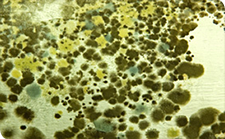
It is a common misconception that mold only occurs in unclean or old homes. In fact, even the neatest homes can become victims to mold, given the right circumstances. In this article, we will provide you with an overview of some of the different types of mold you might discover in and around your home.
Alternaria
Alternaria is
probably the most common mold that can be found both inside and
outside your home. This type of mold thrives in damp and dark places.
It will usually be found near sinks, showers, or moist cupboards
(such as those below your kitchen sink). This mold can be harmful. It
can cause an increase in asthma attacks. It may even trigger allergic
reactions.
Aspergillus
Aspergillus mold is found
indoors and is highly common. It should be dealt with quite quickly,
as it can cause minor health issues when inhaled. However, in people
with respiratory sensitivities, if they are exposed to Aspergillus,
they may display more severe symptoms, such as infections, allergic
reactions, and inflammation of the lungs.
Aureobasidium
This mold is
most commonly found on wood, such as furniture and floors. It can
also be found on painted walls, wallpaper, windows, and caulking.
This mould is pink and black in color, making it easy to identify.
Most people exposed to this will develop allergic reactions. This
type of mold has been noted to cause quite severe reactions in people
who are sensitive.
Chaetomium
This mold usually
appears after water damage. It is commonly seen on drywall. This mold
can be identified by its musty or “old” smell where it is
growing.
Cladosporium
This mold likes
both cold and warm areas, such as flooring. It also infests old
fabrics. Cladosporium can also negatively impact respiratory tracts,
often causing breathing problems in those who are sensitive to its
type.
Fusarium
Fusarium prefers
cold and wet surroundings. Therefore, it can often be found in homes
with damp, dark basements. Fusarium can often be found carpeted areas
and dense fabrics. Like many other types of mold, this will also
cause respiratory issues.
Penicillium
Penicillium is a
type of mold that likes to settle deep within indoor structures, such
as insulation, damp furniture, and carpets. This mold can be quite
dangerous, as it can spread very quickly and can be the cause of
sinus infections, inflammation of the lungs, and allergic reactions.
Stachybotrys Chartarum
This mold is commonly known as black mold or toxic mold. It acquired this name because it creates mycotoxins, which are toxic compounds. This type of mold has a musty smell and thrives in continuously damp areas, like air conditioning ducts. This mold can also severely impact the health of homeowners, causing breathing issues, sinus infections, depression, fatigue, and asthma attacks. This is just a short list of problems it can cause, which is why it gets such a bad rap: it deserves it.
Serpula Lacrymans
This type
of mold is commonly found outside or on wood surfaces. It has a
yellow appearance and causes dry rot in wood. This is important for
the environment and aids in the natural breakdown of wood into
fertilizer. It is one of Mother Nature’s helpers.
Trichoderma
Trichoderma
thrives in damp areas. It also produces mycotoxins, which cause
similar health impacts to that of the dreaded Stachybotrys Chartarum.
Ulocladium
This mold is found
inside and outside. It thrives in severe food damage. This mold has a
likelihood to cause allergic reactions and infections. It is best
dealt with swiftly.
No matter the type, you should quickly identify and decide how to deal with mold if and when you find it. Prevention is the best measure for protecting your home, indoor environment, and your health.






